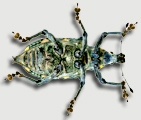Citation:
Date Published:
NovAbstract:
Haplodiploidy is a highly unusual genetic system that has arisen at least 17 times in animals of varying lifestyles, but most of these haplodiploid lineages remain relatively poorly known. In particular, the ecological and genetic circumstances under which haplodiploidy originates have been difficult to resolve. A recent molecular-phylogenetic study has resolved the phylogenetic position of the haplodiploid clade of scolytine beetles as the sister group of the genus Dryocoetes. Haplodiploid bark beetles are remarkable in that the entire clade of over 1300 species are apparently extreme (sib-mating) inbreeders, most of which cultivate fungi for food while some attack phloem, twigs or seeds. Here we present a much more detailed molecular-phylogenetic study of this clade. Using partial sequences of elongation factor 1-alpha and the mitochondrial small ribosomal subunit (12S), we reconstructed the phylogeny for 48 taxa within the haplodiploid clade, as well as two species of the diplodiploid sister genus Dryocoetes. Results indicate that the genus Ozopemon is the basal lineage of the haplodiploid clade. Since Ozopemon, Dryocoetes and other outgroups are phloem-feeding, this strongly suggest that haplodiploidy and inbreeding evolved in a phloem feeding ancestor. Following the divergence of Ozopemon there is a series of extremely short internodes near the base of the clade, suggesting a very rapid rate of diversification in early Miocene (based on fossil evidence and sequence divergence). Among the many substrates for breeding and food resources utilized within this species-rich clade, the cultivation of yeast-like ambrosia fungi in tunnels deep into the wood predominates (nearly 90% of the species). The number of transitions to feeding on such fungi was few, possibly only one, and is perhaps an irreversible transition. The habit of feeding on fungi cultured in xylem makes it possible for the beetles to use a great variety of plant taxa. This extreme resource generalism, in conjunction with the colonization advantage conferred by haplodiploidy and inbreeding, may have promoted the rapid diversification of this clade. (C) 2000 The Linnean Society or London.
Notes:
373RWTimes Cited:40Cited References Count:76
